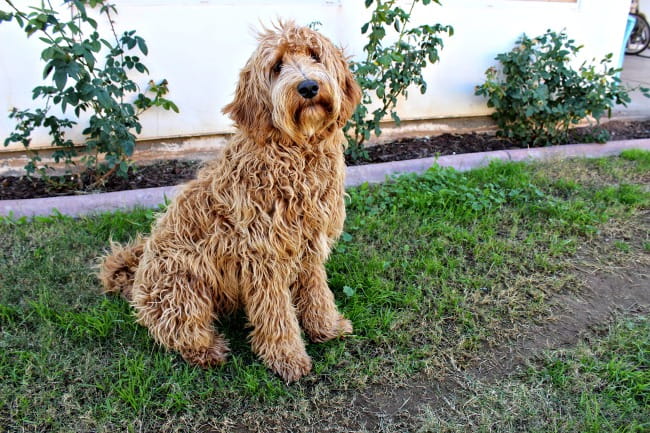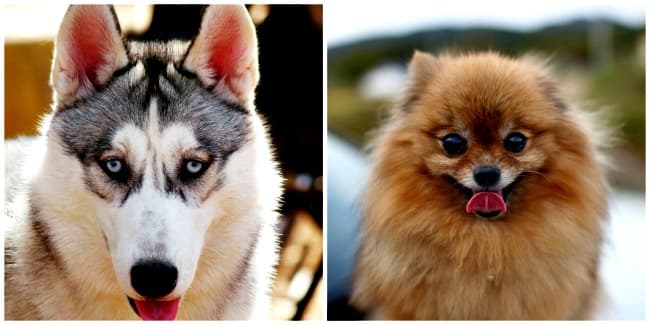FYI: If you buy something through a link on this site I may earn a commission - at NO extra cost to you.
About Designer Dog Breeds
Designer dog breeds are the result of initially breeding two PUREBRED dogs of DIFFERENT BREEDS.
The most well known designer dog (and in fact, the very FIRST designer dog breed) is the Labradoodle, which is the combination of a purebred Labrador Retriever with a purebred Poodle.
The Labradoodle first appeared in the 1970's when it was created to fill the need of a seeing-eye dog for a man with an allergy to most dog coats. Labradors are of course, traditionally used as guide dogs/seeing eye dogs, and Poodles have low-allergy coats. The Labradoodle was a perfect fit!
Other popular combinations you're probably familiar with include the:
- Goldendoodle (Golden Retriever X Poodle)
- CockaPoo (Cocker Spaniel X Poodle)
- PomaPoo (Pomeranian X Poodle)
- Puggle (Pug X Beagle)
This first generation of the new breed is a 50:50 genetic mix of both the original breeds, and these dogs are called F1 crosses (or just F1's).
 Labradoodle
Labradoodlerandom fact:
WHY YOUR DESIGNER DOG ISN'T REALLY A HYBRID
Designer dogs are also often called hybrid dogs, but this isn't scientifically accurate because hybrids are a cross between two different species of animal, rather than two different types of the same species.
Designer Dog Breed Or Mixed Breed?
So, what's the difference between a designer dog and a mixed breed?
 Mixed breed dog
Mixed breed dogWell, before designer dogs were a thing, any dog that wasn't purebred was a mixed-breed, but now there's a distinction.
Any 'hybrid' dog can trace (with proof) his/her ancestry back to two, purebred dogs.
Mixed breed ancestry is usually a complicated blend of many different dogs, some may be purebred, others mixed breeds themselves.
More often than not most of the branches on the family tree of a mixed breed puppy are unknown but the family tree of designer dog breeds has a definite structure:
- The
first generation designer dog (known as an F1), is the direct result of
mating two purebred dogs of different breeds.
- The second generation (F2)
results from the mating of two F1 dogs
- An F3 pup is the result of a mating two F2 hybrids.
Then there are what's called 'backcross' puppies:
- F1b puppies are the result of breeding an F1 hybrid back to a purebred dog of either the mother or fathers breed (eg. an F1 Goldendoodle X purebred Golden Retriever).
- F2b pups are produced by breeding an F1 dog to an F1b backcross dog.
Just because two purebred dogs are mated and their puppies are F1 crosses, or designer dogs, that doesn't mean that they (and their descendants) are automatically a 'breed'.
There need to be three generations of careful, documented breeding before a breed can be officially recognized. Even then, it won't be recognized as a formal breed by the AKC (although both designer dogs and mixed breeds are now eligible to be registered through the AKC Canine Partners Program and receive an AKC ID number which allows them to participate in AKC events).
The UK Kennel Club (KC) is the equivalent of the AKC here in the States and it also does not currently register or recognize designer dog breeds.
However there are organizations which will officially register designer dog breeds, including:
- International Designer Canine Registry (designercanineregistry.com)
- American Canine Hybrid Club (achclub.com)
- National Hybrid Registry (nationalhybridregistry.com)
- Designer Breed Registry (designermixes.org)
 Goldendoodle
GoldendoodleIn 2018, designerdogsofamerica listed these as the Top 10 most popular designer dog breeds in the USA:
- Puggle (Pug X Beagle)
- Cockapoo (Cocker Spaniel X Poodle)
- Goldendoodle (Golden Retriever X Poodle)
- Labradoodle (Labradoodle X Poodle)
- Schnoodle (Schnauzer X Poodle)
- Yorkipoo (Yorkshire Terrier X Poodle)
- Maltipoo (Maltese X Poodle)
- Mal-Shi (Maltese X Shih Tzu)
- Pomsky (Pomeranian X Husky)
- Aussiedoodle (Australian Shepherd X Husky)
Pulling together information from several sources I came up with an updated list of most popular designer dog breeds in the USA as of 2022. I've listed the breeds in alphabetic order, however the lively, popular Goldendoodle does seem to take first place on most lists and the Bernedoodle and Chiweenie have become pretty popular.
- Bernedoodle
- Cavachon
- Chiweenie
- Cockapoo
- Goldendoodle
- Maltipoo
- Morkie
- Pomsky
- Puggle
 Bernedoodle
BernedoodleAnother Random Fact...
The number of designer dog breeds is increasing at an incredible, and potentially worrying, rate.
While there are only around 160 AKC recognized pure breeds, there are over 500 designer dog breeds. How many more variations are possible is open ended at this point.
The Pros & Cons of Designer Dogs
It's kind of a mixed bag when it comes to this, and there are strong opinions on both sides of the fence.
Health
It's well known that every purebred dog breed is troubled by at least one (and usually many more), genetic or hereditary illnesses or problems. This is due to the level of inbreeding that takes place in order to keep a breed 'pure'.

Available research shows that
designer dog breeds, and mixed breeds, are less likely to suffer from
genetic weaknesses and are generally healthier overall than their
purebred cousins.
However, it's very important to pay attention to the specific purebreds that are producing a particular hybrid.
If both parent dog breeds share the same genetic weaknesses, there's at the potential for a double dose of problems in the resulting puppies.
For example, if you cross breed two purebreds who each have a predisposition towards eye and eye-lid problems (such as Pugs, Boston Terriers or Pekingnese), the puppies are very likely to have problems in this area. And they may be more serious than in the original breeds themselves.
F2 and F3 generations are more at risk for the appearance of recessive traits, both structural and cosmetic, and this means they are potentially at a higher risk for troubling health issues related to genetics.
The Best Of Both Worlds?
Not necessarily!
Admittedly one of the first designer dog breeds was the Labradoodle, which was originally bred to combine two individual, breed specific traits with a particular purpose in mind.
The Labrador Retrievers' superior performance as a service dog, and the Poodles' non-shedding, non-allergenic coat. This combination produced a great guide dog for people with allergies.
It works quite well in theory, but due to the nature of genetics, it's not always a 'sure thing'.
Designer dog breeders need to work hard and be conscientious about choosing the dogs they breed, and pairing them up, so that the desirable genes are passed on rather than undesirable ones. Several generations have to be allowed to mature in order for the true results of any particular breeding/s to be evaluated accurately.
When it comes to the small or tiny designer dog breeds, health problems are more likely to occur than they are with the larger breeds.
 Puggle
PuggleAn F1 (first generation) Labradoodle or Goldendoodle can have a
lab like coat that sheds, an F2 is more likely to have a hypoallergenic,
low to non-shed coat.
It's also not safe to expect puppies from a certain breeding to get only the desirable physical/behavioral traits.
They're just as likely to inherit the undesirable ones, and each individual puppy in the litter can be quite different from it's litter mates.
Be realistic when considering a hybrid puppy, and if there are characteristics in either of the foundation breeds that you really don't want in your dog, don't choose that particular combination.
Predictable or Not?
With purebred dogs you have a pretty accurate idea of your puppy's eventual size, coloring and breed characteristics. With mixed breeds it can be a complete lottery!
Designer dog breeds fall somewhere between these two extremes.
 Cockapoo
CockapooThey're
not as predictable as a purebred dog, but F1 and
F2 generation hybrids will show a selection or combination of
characteristics found in the original purebred dogs that founded the new
'breed'.
It's also important to realize that each individual designer dog breeders' stock will vary from those of another breeder, as there are no recognized 'breed standard' to adhere to (as there is with purebred dogs).
The 'look' of each hybrid is less 'standardized' than that of a mainstream purebred.
Cost of Designer Dogs
Purebred dogs are usually expensive. The cost of responsible breeding practices, proper health screening, superior nutrition, training, socialization are higher than many dog owners realize so good, ethical breeders rarely make any kind of significant profit.
Mixed breed dogs are generally inexpensive, given away 'for free', or adopted from a city pound or animal rescue organization.
Although designer dog breeds are a type of mixed breed dog, they are usually expensive, just like their purebred cousins... and for the same reasons.
Small breed dogs tend to have smaller litters than medium or larger sized breeds and so the tinier designer dogs are sometimes even more expensive due to the balance of supply and demand.
Some hybrids are the mixture of two breeds who are significantly different in size, eg. the Pomsky which is a Husky Pomeranian cross. Because of the obvious difficulty and dangers of breeding dogs who have such a size disparity, artificial insemination is used. This is another breeding cost which is passed onto the new puppy owners.

Many breeders are hard working, honest and ethical, taking great care of their dogs and puppies and doing it for the love and enjoyment of their dogs. However there are also many unscrupulous breeders who take advantage of people's willingness to pay high prices for designer puppies. They are in the business for money, not for the love of the dogs, and puppies they produce are much more likely to have health or temperament problems.
Please research carefully before buying a designer pup or dog and make sure the breeder you choose is the former, not the latter.
Dog DNA Tests
There are lots of reasons why you might want to get DNA information on your puppy/dog.
Perhaps you want to be sure that the purebred you bought (but who doesn't have 'papers') isn't a mixed breed after all.
Other times it's to get info. that might help diagnose an unexpected health issue, explain behavior, get more background on a newly rescued dog, or just out of simple curiosity.

There are simple, ready-to-use, DIY tests that can help you learn more about the
genetic background of your dog, right from your own home.
All you need to do is use the kit to take a simple mouth swab, send it off to a lab, and wait for the results.
This Wisdom Panel 3.0 Canine DNA Test Kit tests for upward of 350 dog breeds and can verify that your designer dog is what he claims to be. It can also certify purebred ancestry or provide accurate breed ancestry information for mixed breed dogs, plus it screens for the MDR1 gene (which when present can cause serious, even fatal, reactions to some commonly used drugs).
The Embark Dog DNA Test Kit also tests for over 350 dog breeds as well as for 215 individual health risks, including the MDR1 gene.
This type of information is hugely important for a variety of reasons, including:
Health: Every breed has a predisposition to certain canine health issues and being aware of this can help you protect your pet and make sure he gets any screening he needs as well as being ready and able to recognize symptoms should they arise.
Behavior & Training: Just as health issues are genetically transmitted, so are a lot of in-born breed characteristics and behaviors. It's easier to keep your pup happy and well-behaved if you understand how he 'ticks' and tailor your training, corrections and daily routine to his needs.
you might also like...
- Home
- Dog Breed Information
- Designer Dog Breeds
FTC Disclosure: Some pages on this site contain affiliate links. I may earn on qualified purchases.





